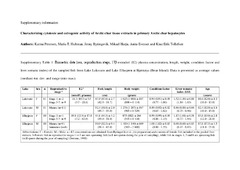Blar i forfatter "Tollefsen, Knut Erik"
-
Characterizing cytotoxic and estrogenic activity of Arctic char tissue extracts in primary Arctic char hepatocytes
Petersen, Karina; Hultman, Maria Thérése; Bytingsvik, Jenny; Harju, Mikael; Evenset, Anita; Tollefsen, Knut Erik (Journal article; Tidsskriftartikkel; Peer reviewed, 2017-09-01)Contaminants from various anthropogenic activities are detected in the Arctic due to long-range atmospheric transport, ocean currents, and living organisms such as migrating fish or seabirds. Although levels of persistent organic pollutants (POPs) in Arctic fish are generally low, local hot spots of contamination were found in freshwater systems such as Lake Ellasjøen at Bjørnøya (Bear Island, ... -
Effects of chronic dietary petroleum exposure on reproductive development in polar cod (Boreogadus saida)
Bender, Morgan Lizabeth; Frantzen, Marianne; Vieweg, Ireen; Falk-Petersen, Inger-Britt; Johnsen, Helge Kreutzer; Rudolfsen, Geir; Tollefsen, Knut Erik; Dubourg, Paul; Nahrgang, Jasmine (Journal article; Tidsskriftartikkel; Peer reviewed, 2016-10-04)Increasing human activities in the Arctic raise the risk of petroleum pollution, thus posing an elevated risk for Arctic organisms to be chronically exposed to petroleum compounds. The endocrine disrupting properties of some of these compounds (i.e. polycyclic aromatic hydrocarbons [PAHs]) present in crude oil may have negative effects on the long and energy intensive reproductive development of ... -
In silico site-directed mutagenesis of the Daphnia magna ecdysone receptor identifies critical amino acids for species-specific and inter-species differences in agonist binding
Evenseth, Linn M.; Kristiansen, Kurt; Song, You; Tollefsen, Knut Erik; Sylte, Ingebrigt (Journal article; Tidsskriftartikkel; Peer reviewed, 2019-06-04)Molting is an essential process in the life cycle of arthropods and is regulated by complex neuroendocrine pathways where activation of the ecdysone receptor (EcR) plays a major role. The EcR forms a non-covalent heterodimer with the ultraspiracle protein (USP) when activated by endogenous ecdysteroids, but can also be activated by several insecticides and other environmental chemicals. Environmental ... -
Release of chitobiase as an indicator of potential molting disruption in juvenile Daphnia magna exposed to the ecdysone receptor agonist 20-hydroxyecdysone
Song, You; Evenseth, Linn Mari; Iguchi, Taisen; Tollefsen, Knut Erik (Journal article; Tidsskriftartikkel; Peer reviewed, 2017-08-29)During arthropod molting, the old exoskeleton is degraded and recycled by the molting fluid. Chitobiase, a major chitinolytic enzyme in the molting fluid, has been widely used as a biomarker to indicate endocrine disruption of molting in arthropods under environmental stress. Although release of chitobiase was extensively studied in organisms exposed to molting-inhibiting chemicals, enzymic association ... -
Transcriptomic analysis reveals dose-dependent modes of action of benzo(a)pyrene in polar cod (Boreogadus saida)
Song, You; Nahrgang, Jasmine; Tollefsen, Knut Erik (Journal article; Tidsskriftartikkel; Peer reviewed, 2018-10-21)Polar cod (<i>Boreogadus saida</i>) has been used as a model Arctic species for hazard assessment of environmental stressors such as polycyclic aromatic hydrocarbons (PAHs). However, most of the PAH studies using polar cod rely on targeted biomarker-based analysis thus may not adequately address the complexity of the toxic mechanisms of the stressors. The present study was performed to develop a ... -
Whole-Organism Transcriptomic Analysis Provides Mechanistic Insight into the Acute Toxicity of Emamectin Benzoate in Daphnia magna
Song, You; Rundberget, Thomas; Evenseth, Linn Mari; Xie, Li; Gomes, Tania; Høgåsen, Tore; Iguchi, Taisen; Tollefsen, Knut Erik (Journal article; Tidsskriftartikkel; Peer reviewed, 2016-10-05)Emamectin benzoate (EMB) is an antisea lice chemical widely used in the aquaculture that may also unintentionally affect nontarget crustaceans in the environment. Although the adverse effects of this compound are well documented in various species, the full modes of action (MoAs) are still not well characterized. The current study was therefore conducted to characterize the MoAs of EMB and link ...


 English
English norsk
norsk




